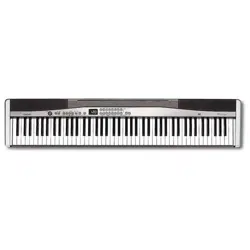Loading ...
Loading ...
Loading ...

E-15
Playing Rhythms
413A-E-017A
Chord Types
CASIO CHORD accompaniment lets you play four
types of chords with minimal fingering.
NOTE
• It makes no difference whether you press black or
white keys to the right of a major chord key when
playing minor and seventh chords.
■ FINGERED
In this mode, you specify chords by playing them as
you would on a piano, inside the accompaniment
keyboard range. To specify a C-chord, you would play
C-E-G.
FINGERED Accompaniment Keyboard and Melody
Keyboard
IMPORTANT!
• The accompaniment keyboard can be used for playing
chords only. No sound will be produced if you try playing
single melody notes on the accompaniment keyboard.
Chord Types
Major chords
Press one accompaniment key.
Note that the chord produced
when you press an
accompaniment keyboard key
does not change octave,
regardless of which key you use
to play it.
Minor chords (m)
To play a minor chord, keep the
major chord key depressed and
press any other accompaniment
keyboard key located to the right
of the major chord key.
Seventh chords (7)
To play a seventh chord, keep the
major chord key depressed and
press any other two
accompaniment keyboard keys
located to the right of the major
chord key.
Minor seventh chords (m7)
To play a minor seventh chord,
keep the major chord key
depressed and press any other
three accompaniment keyboard
keys located to the right of the
major chord key.
Example
C Major (C)
CC DE F
##
EFGA
ABB
CC DE FE
#
C minor (Cm)
CC DE F
##
EFGA
ABB
CC DE FE
#
C seventh (C7)
CC DE F
##
EFGA
ABB
CC DE FE
#
C minor seventh
(Cm7)
CC DE F
##
EFGA
ABB
CC DE FE
#
NOTE
• See the “Fingered Chord Chart” on page A-4 for
details on playing chords with other roots.
*1: Inverted fingerings cannot be used. The lowest
note is the root.
*2: The same chord can be played without pressing
the 5th G.
NOTE
• Except for the chords specified in note*
1
above,
inverted fingerings (i.e. playing E-G-C or G-C-E
instead of C-E-G) will produce the same chords as
the standard fingering.
• Except for the exception specified in note*
2
above,
all of the keys that make up a chord must be
pressed. Failure to press even a single key will not
play the desired FINGERED chord.
Accompaniment
keyboard
Melody keyboard
CCm
Cdim
Caug *
1
Csus4
C7 *
2
Cm7 *
2
Cmaj7 *
2
Cm7
5
C7
5
*
1
C7sus4
Cadd9
Cmadd9 CmM7 *
2
Cdim7 *
1
Loading ...
Loading ...
Loading ...
